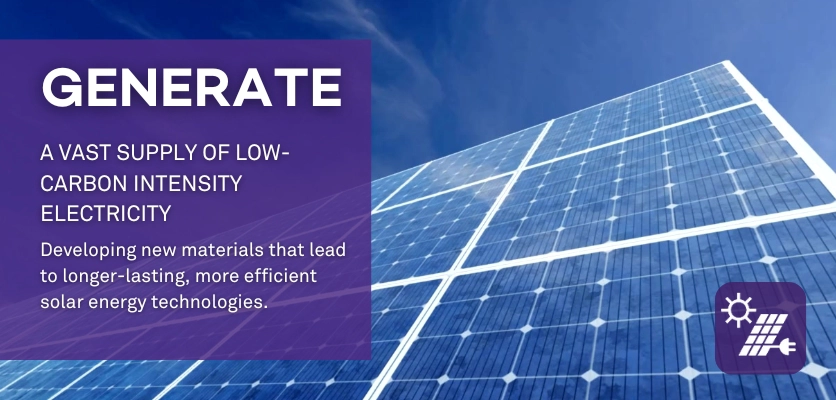The Generate Pillar
The Trienens Institute Generate pillar aims to develop a new class of solar energy production with high-efficiency, stable solar cell materials to power the next generation.
Research and innovation are central to the work of the Paula M. Trienens Institute for Sustainability and Energy. Together, the Trienens Institute R&D pillars are building a suite of complementary solutions for a vibrant, sustainable future. Northwestern researchers, who are global leaders in their fields, are guiding diverse teams of experts to progress in this urgent mission.

Why do we need solar energy?
Since 1980, worldwide electricity consumption has more than tripled to meet the needs of the of over eight billion people who now inhabit the planet. Growing with the global population are demands for energy sources that deplete natural resources, create carbon emissions, and contribute to climate change. And while new development and technology continues to raise global energy demands, scientists and engineers are refining the process of capturing the most abundant natural energy source: the sun.
What role does solar play in the energy transition?
The original source of renewable energy, solar is a critical part of the clean energy portfolio as it does not produce greenhouse gas emissions or other pollutants. With multi-decade lifespans, solar panels have a minimal carbon footprint and are made from materials like aluminum, glass, silicon, and other increasingly recyclable materials.
Solar energy is already part of the national landscape—spanning acres of farmland and city rooftops. But generating enough energy to shift towards solar as a main power source will require a new generation of technology that is affordable, accessible, reliable, and resilient in harsh environments.
The Northwestern Solution
With a history of cutting-edge solar cell innovation, Northwestern researchers are leading the charge to innovate and develop increasingly efficient and reliable technologies. The Generate pillar aims to develop a new class of solar energy production and to secure funding to advance the efficiency and stability of solar cell materials. The pillar is bringing together laboratories from across the university to earn this support and continue to build on the solar energy legacy at Northwestern.
The Experts
Current Projects
LEARN MOREIn the News
Advance in perovskite solar cells improves efficiency, durability
Durability improvements to perovskite solar cells bring them closer to commercialization | FULL STORY >Stability of perovskite solar cells tripled with protective coating
Newly developed coated cells deliver solar power conversion efficiency at groundbreaking rate | FULL STORY >New chemical method stabilizes tin-containing perovskites
Researchers added diamine to remove extra tin from the perovskite surface and form a stable barrier layer | FULL STORY >Researchers take a step closer to better, more affordable solar cells
Innovative technique leads to perovskite-based solar cells with record-breaking efficiency | FULL STORY >
How can I support the development of next generation solar technology?
Consider making a gift in support of the Institute. For industry professionals and other leaders who wish to go deeper, consider corporate partnership opportunities. For broader impact, consider joining the Trienens Institute Executive Council.



